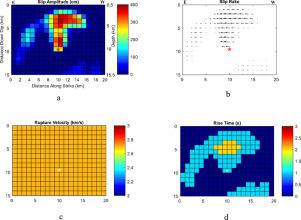Physics of the Earth and Planetary Interiors ( IF 2.4 ) Pub Date : 2021-03-06 , DOI: 10.1016/j.pepi.2021.106688 Atefeh Saltanatpouri , Stephen Hartzell , Habib Rahimi , Rahmatollah Rouhollahi , Rouhola Amiri Fard

|
We use combined teleseismic and strong motion data sets to investigate finite-fault slip models for a double of earthquakes that occurred on August 11, 2012, in northwestern Iran near the cities of Ahar and Varzaghan. The data include teleseismic P-waveforms retrieved from broadband seismic stations located between 30°–94° from the earthquakes and local strong motion data recorded by the Iran Strong Motion Network, installed and operated by the Building and Housing Research Centre. We first invert teleseismic P-waveforms and local strong motion data separately. For the first event (12:23 UTC), the teleseismic broadband inversion yields a somewhat deeper and simpler distribution of slip than the local strong motion inversion. The strong motion inversion results in a more complex distribution because of higher frequency content but can also be influenced by complexities in the propagation path. For the second event (12:34 UTC), the slip distribution from strong motion data is more similar to the teleseismic result and shows a simple slip area with a small relative movement to the west. To resolve the differences between the results of these two data sets and obtain a better constrained slip model, we perform a joint inversion of teleseismic broadband and local strong motion data.
The joint inversion for the first event shows two asperities with a maximum slip of 3.9 m up- dip from the hypocenter and extending to the west between depths of 1 and 5 km. A second narrower high-slip area is seen just above the hypocenter from 6 to 10 km depth. The total moment for this earthquake is calculated to be Mo = 3.8 × 1025 dyn-cm (3.8 × 1018 N.m) (Mw 6.4). For the second event, the results of the joint inversion show a simple slip distribution that is mainly confined in a single patch around the hypocenter with a depth range from about 10 to 13 km and maximum slip of 1.9 m. We compute a total seismic moment of Mo = 1.6 × 1025 dyn-cm (1.6 × 1018 N.m) (Mw 6.1) for the second event. The largest stress drops for the first event occur above the hypocenter with an average stress drop over the rupture area of 120 bar (12 Mpa). For the second event, the maximum stress drop occurs at the reported focal depth with an average stress drop over the rupture area of 80 bar (8 Mpa).
中文翻译:

使用远震宽带和当地强运动数据的联合反演,得出2012年8月11日伊朗阿哈尔-瓦尔扎汉两次地震的滑动分布和破裂历史
我们使用组合的地震和强运动数据集来调查有限断层滑移模型,该模型对2012年8月11日在伊朗西北部阿哈尔和瓦尔扎甘(Varzaghan)市附近发生的两次地震进行了研究。数据包括从位于地震30°-94°之间的宽带地震台站中检索到的远震P波形,以及由伊朗建筑和住房研究中心安装和运营的伊朗强运动网络记录的当地强运动数据。我们首先分别反转远震P波形和局部强运动数据。对于第一个事件(UTC时间12:23),远震宽带反演比局部强运动反演产生的滑动分布更深,更简单。由于较高的频率含量,强烈的运动反转会导致分布更加复杂,但也会受到传播路径复杂性的影响。对于第二个事件(UTC时间12:34),来自强运动数据的滑移分布与远震结果更相似,并且显示了一个简单的滑移区域,向西的相对运动较小。为了解决这两个数据集的结果之间的差异并获得更好的约束滑移模型,我们对远震宽带数据和局部强运动数据进行了联合反演。
第一个事件的联合反演显示了两个凹凸不平处,最大震源从震中上移了3.9 m,并向西延伸了1至5 km的深度。在距震源中心6到10 km的深度上方,可以看到第二个较窄的高滑区域。计算出该地震的总力矩为M o = 3.8×10 25 dyn-cm(3.8×10 18 Nm)(M w 6.4)。对于第二个事件,联合反演的结果显示出简单的滑移分布,主要分布在震源周围的单个斑块中,深度范围约为10至13 km,最大滑移为1.9 m。我们计算出的总地震矩为M o = 1.6×10 25 dyn-cm(1.6×10 18 Nm)(M w 6.1)。第一次事件的最大应力降发生在震源上方,破裂区域的平均应力降为120 bar(12 Mpa)。对于第二个事件,最大应力下降发生在所报告的焦深处,破裂区域的平均应力下降为80 bar(8 Mpa)。











































 京公网安备 11010802027423号
京公网安备 11010802027423号